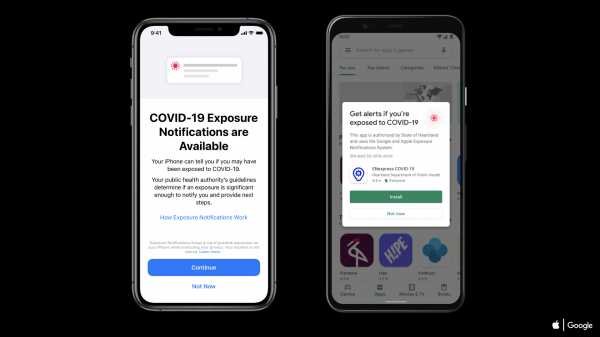
This story is part of a group of stories called

Uncovering and explaining how our digital world is changing — and changing us.

The Apple-Google exposure notification tool is getting a major upgrade. The two companies just announced the debut of Exposure Notifications Express, which will enable their exposure notification tool to work without a public health agency needing to build or maintain an app around it. Now, states or public health authorities that don’t have the resources or desire to build an app, but still want to take advantage of the tool, will be able to do so.
Streamlining the process of getting people to use this tool is a big deal. The Apple-Google tool is one of the most promising Big Tech attempts to help stop or contain the Covid-19 pandemic, but it has struggled to win over a lot of users. Without widespread adoption, contact tracing apps, including the ones that incorporate the Apple-Google technology, are basically useless: Studies have shown that at least 60 percent adoption is needed for a contact tracing app to be effective. But some experts say far less than that is needed when combined with human contact tracers.
“We estimate that a well-staffed manual contact tracing workforce combined with 15 percent uptake [in a contact tracing app] could reduce infections by 15 percent and deaths by 11 percent,” Professor Cristophe Fraser in the department of health at Oxford University said in a statement.
So far, Maryland, Nevada, Virginia, and Washington, DC, have already signed on to use Exposure Notifications Express, while six states — Alabama, Arizona, North Dakota, Wyoming, Nevada, and Virginia — have apps that use the tool. While several other countries have apps that use the tool, the United States has left it to individual states to figure out their own contact tracing efforts, which have been less than enthusiastic. Although Apple and Google announced the exposure notification tool in April and launched it a month later, it wasn’t until August that Virginia became the first state to release a contact tracing app that used the tool. Virginia told Recode that it spent nearly $230,000 to develop the app and $1.5 million to market it — money that came from the federal CARES Act. Nearly 500,000 Virginians have downloaded the app so far, which is a small portion of the state population of about 8.5 million people.
One huge upside to the new Exposure Notifications Express tool, however, is that states no longer have to spend the time or money developing their own apps. They may not have to do much marketing, either. In states or regions that have enabled Exposure Notifications Express, a prompt will pop up on phones with the latest version of Apple’s or Android’s operating system and alert the user that the tool is available to them. The user just taps the screen to enable it. For Apple users, that’s all it takes to turn the tool on. Android users will then need to download an app that Google automatically generates for public health authorities. All public health authorities have to do is give Apple and Google some basic information and set up servers to host Bluetooth keys and exposure verification.
“As the next step in our work with public health authorities on Exposure Notifications, we are making it easier and faster for them to use the Exposure Notifications System without the need for them to build and maintain an app,” Apple and Google said in a statement. “Exposure Notifications Express provides another option for public health authorities to supplement their existing contact tracing operations with technology without compromising on the project’s core tenets of user privacy and security.”
Countries around the world have spent weeks trying various methods of contact tracing. The basic idea is that public health agencies can use contact tracing to notify people when they’ve potentially been exposed to the coronavirus so they can then quarantine and get tested accordingly. Contact tracing also helps track the virus’s spread, and that part is usually done manually, using human beings. Digital contact tracing tools, however, are designed to do this by using devices like smartphones to alert users when they’ve been close to a device tied to someone who’s potentially been exposed to the virus. The process of notifying people of potential exposure is where the Apple-Google exposure notification tool comes in handy.
The tool works by sending out and receiving anonymous Bluetooth “keys” from nearby phones that also have the tool enabled. If someone tests positive for the coronavirus, they can notify their public health authority, which will then send out alerts to any phones that were in proximity to the infected person’s phone. The system is designed to keep as much information as possible on individual phones and preserve user privacy. Very little information goes back to the public health authority, and users always have the option to opt in or out of the tool. Apple and Google have said that user privacy was a major consideration in their development of the tool, to encourage as many people to use it as possible. The two companies worked together on the project to allow the tool to work across their iOS and Android operating systems.
Contact tracing apps haven’t lived up to their potential so far, but Exposure Notifications Express should make it as easy as possible for public health authorities to implement them and people to enable them. Now we might get a chance to see what digital contact tracing apps can do — if it isn’t too late, six months into the pandemic, for them to make a difference.
Open Sourced is made possible by Omidyar Network. All Open Sourced content is editorially independent and produced by our journalists.
Help keep Vox free for all
Millions turn to Vox each month to understand what’s happening in the news, from the coronavirus crisis to a racial reckoning to what is, quite possibly, the most consequential presidential election of our lifetimes. Our mission has never been more vital than it is in this moment: to empower you through understanding. But our distinctive brand of explanatory journalism takes resources — particularly during a pandemic and an economic downturn. Even when the economy and the news advertising market recovers, your support will be a critical part of sustaining our resource-intensive work, and helping everyone make sense of an increasingly chaotic world. Contribute today from as little as $3.
Sourse: vox.com






